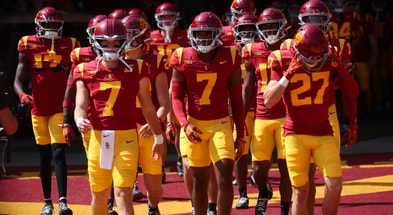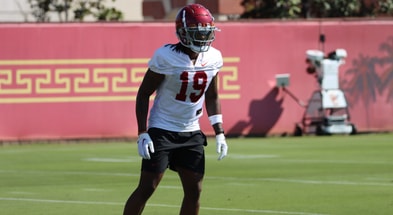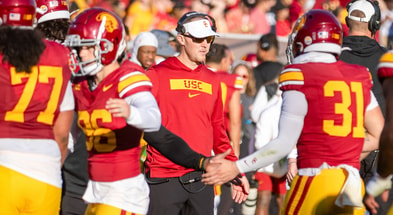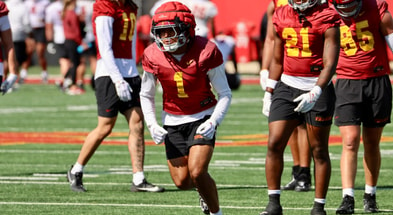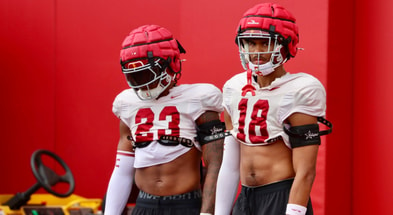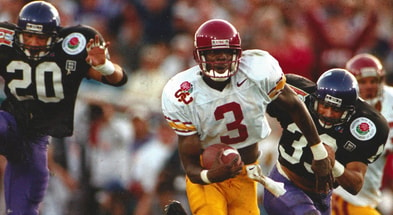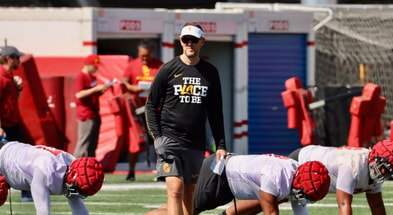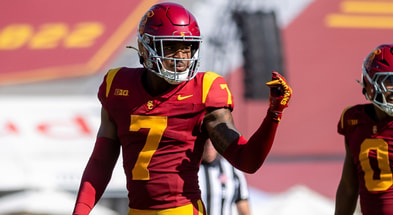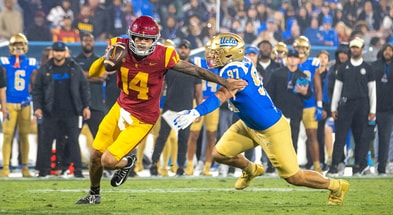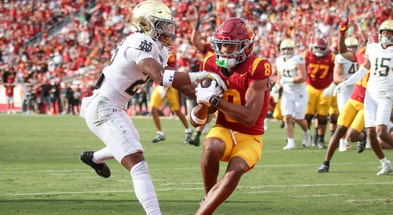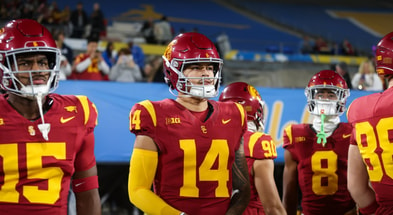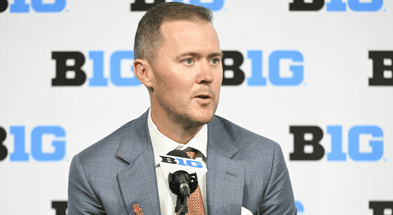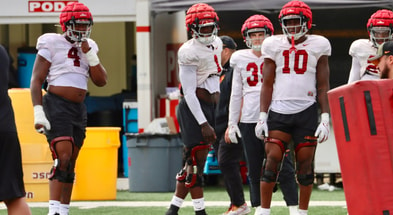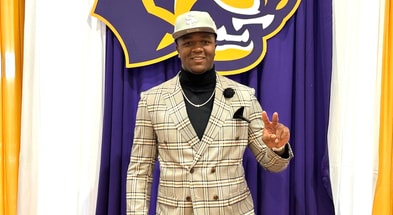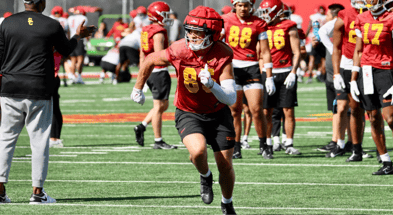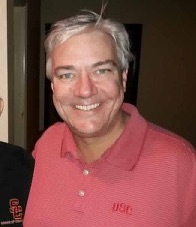Musings from Arledge: What USC's 2024 offense means for the 2025 Trojans
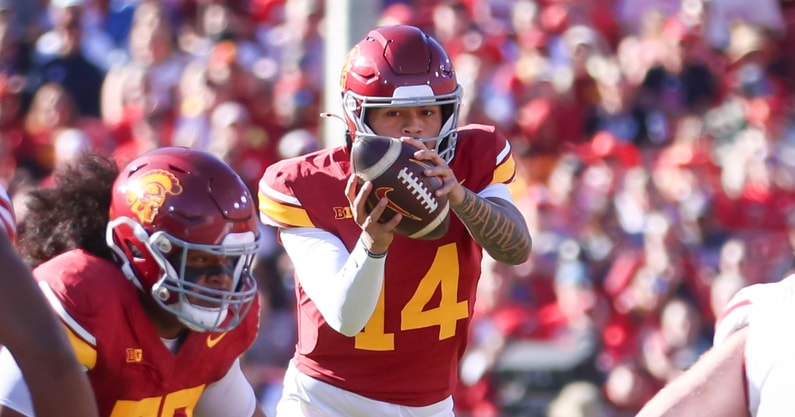
This is the first of a two-part look at what went right and what went wrong in 2024 for the USC Trojans as a way of projecting what we might see in 2025. Today we focus on the offense.
When USC hired Lincoln Riley, the expectation was that USC would always have a very good offense. Whatever criticisms you might have of Riley, he was the most proven offensive coach in college football, and his success on that side of the ball continued through his first two years at USC.
At first glance, USC’s 2024 offense was also solid. The Trojans were 23rd in the country in total offense and 23rd in yards per play. Those are decent numbers. But USC was only 51st in scoring offense. That’s not great. And the reason was Riley’s great love, the passing game, which wasn’t very good—and, for a Lincoln Riley offense, was shockingly bad.
USC was 101st in the country in yards per completion, 120th in interceptions thrown, and 64th in passing efficiency. USC threw the ball a lot, but the Trojans were not explosive when they did, and they made a ton of devastating mistakes.
There is a lot of blame to go around. USC’s receiving corps was probably the most disappointing unit on the entire team. They had trouble getting separation, were not physical, and had a lot of drops. After years of USC teams with receivers that made 50-50 balls more like 75-25 balls in USC’s favor, last year’s group struggled in that area. (That started to turn around late in the year when Ja’Kobi Lane went on his touchdown streak.)
But it wasn’t just the receivers. The offensive line struggled in pass protection. There were games where USC would have been better off playing 7 wide receivers and three linemen, being that the tackles were rarely even getting a hand on the edge rushers.
And the quarterbacks—usually the shining jewel of any Lincoln Riley offense—were not good. Both Miller Moss and Jayden Maiava had their moments and made some plays. But neither was consistent, and they both contributed back-breaking turnovers far too often.
It would be a surprise if USC’s receiving corps wasn’t much better this year. Duce Robinson and Zechariah Branch—who didn’t look good at any point after his injury in the middle of his freshman season—had big names and apparently big expectations of NIL money but very meager production. Branch couldn’t get separation, rarely had yards after the catch, and that was when he could catch; Robinson was the most physically impressive receiver I’ve ever seen play that soft. They’re both gone, obviously, and it’s probably for the best.
The running back room looks as good as it has in years. Woody Marks was solid; he’s shifty and has great hands. He didn’t break a lot of tackles, and he wasn’t very fast. Quinton Joyner was bigger and faster, but I’m not sure he has much wiggle in his game. He would have been a solid number-one option this year, but I’m not sure he was a budding superstar. The running back room last year was good and was not the cause of the offensive struggles. But there is good reason to expect this year’s room to be better.
That leaves the two biggest wildcards for 2025: the offensive line and quarterback.
USC simply must be better at tackle. If they’re not, the offense will continue to struggle. Elijah Paige and Mason Murphy both had multiple games last year where they simply could not compete. Paige made Michigan’s Josaiah Stewart a lot of money; he didn’t touch Stewart most of the game. Paige was simply too young and unprepared to play against an edge rusher that good. Murphy was never an offensive tackle.
There is reason to hope that USC will be better this year with an older and more mature Paige on one side and Tobias Raymond on the other. Both will be in their third year in the program, usually a point at which offensive linemen start to come into their own. Justin Tauanuu showed something in the bowl game, and the coaches seem high on him. There is reason for optimism here, USC’s coaches are propping them up, and the fact that USC didn’t get a tackle in the portal suggests they like where they are. (Of course, they didn’t last year, either, and I don’t think anybody liked where that left the roster.) But those three are unproven, and there is absolutely nothing behind them but a bunch of young kids. The season likely turns on whether Paige and Raymond can play competently against the elite edge rushers.
The inside has its own question marks. Lincoln Riley called Alani Noa the best offensive lineman on the team by the end of last season. He should be solid. And they bring in two very experienced vets in J’Onre Reed (who makes my all-interview team no matter what happens on the field) and DJ Wingfield. Riley says Wingfield has been better than he expected, and he said he believed Wingfield was good when USC signed him.
That’s promising. But we’ll see. That’s a lot of question marks upfront.
At the same time, we shouldn’t forget that USC moved the ball against LSU, Penn State, and Notre Dame even with a questionable offensive line last year. Mistakes killed the Trojans. They simply have to get better at protecting the football.
And, above all, that means they need better play at quarterback. Lincoln Riley puts a ton on his quarterback’s shoulders. And last year neither Miller Moss nor Jayden Maiava were ready to shoulder that load, at least not with the surrounding casts they had. And make no mistake: some of the quarterback problems were caused by poor play from the supporting cast. Some, but not all. Both quarterbacks killed USC with turnovers, and many of those came at the worst possible time. Miller Moss was a great Trojan who ultimately forced Riley to bench him because of game-turning interceptions.
Jayden Maiava has talent. He’s a big, strong guy with a big, strong arm and can make all the throws. The question is whether he’s ready to read the field like an elite quarterback. He has another year of experience under his belt, he has a full offseason for the first time in a long time, he’s healthy, he has Makai Lemon and Ja’Kobi Lane (which should help), and he still has Lincoln Riley, college football’s ultimate quarterback whisperer.
I’m expecting major improvement from Maiava this year because I still believe in Lincoln Riley as a quarterback coach. Riley has earned that benefit of the doubt. But a lot of eyes will be on him and Maiava this year. Maiava will throw for lots of yards and touchdowns. That’s almost a given. But for USC to succeed, Riley has to have taught his new pupil to avoid the devastating mistake, especially in big situations against the better teams. For reasons I will discuss in part two, this year’s USC team will be dramatically better than last year’s. USC is better than most of its opponents. But it has four games that the Trojans cannot win if they make big mistakes. If Maiava plays with composure, USC probably plays in a playoff game this year.
And then there’s Lincoln himself, whose reputation as an offensive guru took something of a hit last year. My question is whether Riley is willing to be patient with his run game. If you treat the sacks as passing plays instead of rushing attempts, USC threw the ball about 38% of the time last year—and not because the passing game was great. To the contrary, USC threw more than just about anybody in the country despite having a passing offense that was below average in efficiency, could not make a big play, and provided disastrous turnover after disastrous turnover.
This was confusing in that, statistically, USC ran the ball quite well when it tried. USC averaged 5.16 yards per carry, which compares favorably with some of the elite teams in the country:
Top 10
- 1New
2025-26 CFP, Bowls
Full schedule, times, TV released
- 2Trending
Super Regionals Odds
Betting lines for each Super
- 3
CFP Title Favorites
Ranking Top 20 to win it all
- 4Hot
Chipper Jones
Calls out Kevin O'Sullivan, Georgia baseball
- 5
Ryan Day
Calls for 4 Big Ten CFP bids
Get the On3 Top 10 to your inbox every morning
By clicking "Subscribe to Newsletter", I agree to On3's Privacy Notice, Terms, and use of my personal information described therein.
ND 5.66
Penn State 5.26
USC 5.16
Tennessee 5.03
Ohio State 4.99
Bama 4.63
Oregon 4.33
Texas 4.33
Georgia 4.06.
And USC didn’t abandon the run because it was always playing behind the sticks. USC’s first down success rate was 24th in the country. USC chose not to run.
Some USC fans have argued that USC couldn’t run the ball when the defense knew they were going to, and therefore Riley couldn’t trust his run game. Maybe. Every offense has a harder time running the ball when the defense knows they’re going to, and I’ll concede that the 2024 USC offense’s running attack didn’t look much like USC’s 2005, 1981 or 1972 versions.
But I’m not sure the numbers really support the argument. I looked at USC’s offense in traditional run situations: 3rd and 2 or less, 4th and 2 or less, and any goal line play at or inside the 2-yard line. USC wasn’t terrible in those situations.
In 27 plays on 3rd or 4th down with 2 yards or less to go, USC ran the ball 27 times and threw it 16 times. This means USC ran the ball 63% of the time on these run downs. This was well below average; nationally, teams ran the ball 75.8 % of the time in those situations. Some of the more physical teams ran it a lot more than that; Georgia and Alabama ran more than 80% of the time in those circumstances. USC picked up a first down running on 74% of those attempts, which is right at the national average. They were successful passing on those downs only 69% of the time.
On 16 goal-to-go situations at or inside the 2-yard line, USC ran 11 times, seven times successfully (for a 64% success rate) and threw it three times, failing every time.
What do we make of these numbers? USC trusted its run game less than the average team, but it’s short-yardage passing game was worse than its short-yardage run game, and it’s short-yardage rushing stats weren’t terrible. I suspect if USC’s quarterbacks were more willing to run, they would have been even better.
And this doesn’t take into account all the situations where USC could have run the ball on second and medium and chose to throw it instead. I didn’t chart those, but we probably all remember them.
USC really did need to run the ball more. And USC’s quarterbacks absolutely have to run the ball more. Caleb Williams did not run a lot in 2023, but he made some huge plays with his legs, and simply his running threat kept backside edge players from crashing down and destroying short yardage runs.
USC’s quarterbacks gave the defense an extra defender by rarely keeping the ball on the read option. Moss never even pretended to be a running threat. Maiava was expected to turn that around but never really did, maybe because of his knee injury. He needs to tuck it more in 2025.
One other issue jumped out from this analysis. USC had 54 obvious run downs in its regular season games. But this doesn’t count five plays where USC had false starts in those situations, pushing them outside of a run-heavy situation. This means five times in 59 short-yardage plays—more than 8% of the time!—USC destroyed an advantageous short-yardage down with a false start. That’s a terrible number and absolutely must get turned around.
USC’s offense will be in the top 20 in yards this year. Even last year, with a very unprepared offensive line, underachieving sophomore wide receivers (except for Makai and, at the end of the year, Ja’Kobi), and a new quarterback, USC was in the top 23 in yards and yards per play. They’ll move the ball at least as well this year, and probably a lot better.
The question is whether they can recover the explosiveness that departed when Caleb Williams departed, and whether they can avoid the huge mistakes. Offenses that don’t make big plays but give up big plays are offenses that lose lots of games. I like the skill-position talent and still believe in Lincoln Riley as an offensive coach; we need more than one down year before giving up on him. But last year disproved the theory that Lincoln Riley will always have a great offense. The spotlight will be bright on him and Maiava this year.
